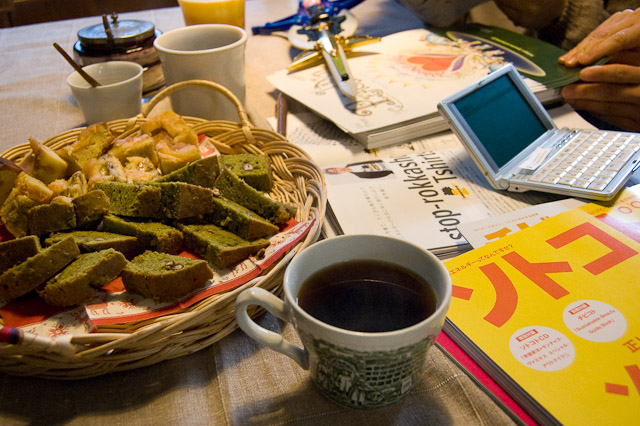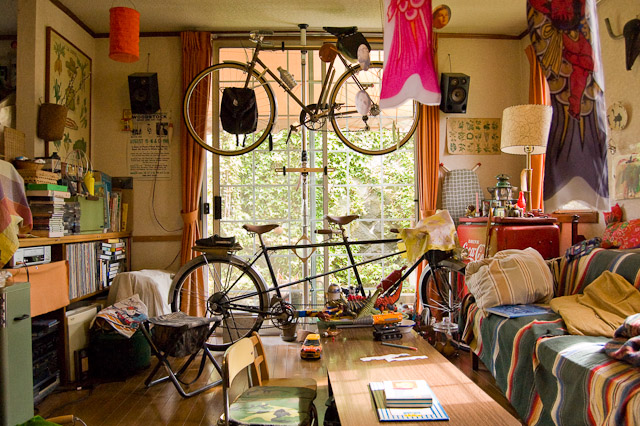Photos from a relaxing afternoon at the home of a couple we met in Fujino last May. She’s a potter and bead artist, and he’s an illustrator/sculptor. Their living room was a colorful clutter of bicycles, vintage toys, posters, drawings. Hanging from the ceiling: a photo-mobile, koinobori carp flags, and a motorized globe. R2-D2 and Ultraman were there, as was a Picasso-inspired bull’s head fashioned out of a bicycle seat and handlebars. The toys seemed to belong to the 50-something dad as much as to the five-year-old son.


Comments
6 responses to “fujino home”
Hardwood floors turn clutter into art.
Haha, true! This clutter collection was also well-curated, though. There was clear aesthetic uniting everything, but my photo doesn’t show it well. The den, which I didn’t photograph, was a mad professor’s workshop of junk metal robots, flying machines, mobiles, vintage Macintosh. Alexander Calder’s crazy Japanese nephew.
I hope you don’t mind a random comment, but I think that your blog is so lovely and well-designed!
I was also wondering what sort of camera you use, as I’m in love with the clear, quiet atmosphere that your pictures create.
Thank you, Lindsay! I don’t mind random comments at all, especially when they come with compliments. I hope you don’t mind my long answer…
Before July 2005, I used a compact camera from the Canon PowerShot series. It was nice and small and easy to use. Easy to carry in my pocket, ready to capture whatever I found worthy of documenting. The PowerShot’s images were clear and vividly colored, and their resolution was high enough for the Web.
However, certain limitations of the PowerShot started to get in my way. Generally speaking, it was too sharp and too slow. The tiny lens, with its high depth-of-field, usually showed everything in focus except when zoomed-in. I wanted to take photos with some things *not* in focus — a bowl of rice with the dishes behind it a soft blur, for example. I wanted more control over selective focus. The shutter lag time — the time between me pressing the button and when the camera “took” the picture, was often so long that the moment I wanted to preserve would vanish while the camera was preparing to capture it. I wanted the picture “take” when I pressed the button, not a second after.
Now I use a Nikon D50, a digital SLR. I’m far from an expert in using it, but it generally does what I want. Its image sensor is larger and more light sensitive than the compact camera’s, giving better image quality and clearer shots in low-light. I use the 18-55mm kit lens that came with the D50 “kit” and a 35mm fixed lens. The 18-55mm lens, while a little slow (dark) and soft, covers most situations I need — from pretty wide to slightly zoomed. I really like the 35mm fixed lens — very bright and sharp — for shots indoors and pictures of food and people.
I like to shoot in RAW format, which gives me lots of data to play around with when I edit in PhotoShop.
Compared with the old PowerShot, the main trade-offs with the D50 are size and cost. The D50, though light, will definitely not hide in my pocket. The price is not really comparable, maybe four to five times as much as the PowerShot when it was new. For one good DSLR lens at the lower-end of the price scale, one could buy a pretty good digital pocket camera. I hope to use this camera for at least another 3 years, though, and the lenses for longer.
I should point out that, of course, the camera doesn’t tell me where to point the lens or when to press the button.
The D50 is a pretty big jump. I used to have a Sony snap and shoot and it broke in 2 years. I think I wore it out. Now I have a Fuji FinePix S6000fd. It is fully manual but also can be set to automatic. The reason I mention it is because it is in the middle of the 2 cameras you mentioned both in quality and about the same price as a smaller point and shoot. It is still in the snap and shoot category but has a better sensor, a 28-300mm lense(which is all anyone would need), is very lite, has a video setting and is easy to use. I use the aperature setting most to capture more light. I find most times I am in a low light situation. Another feature it has is that it uses AA batteries which is helpful when traveling.
Hi, Mark. 28-300 — that’s quite a range.
I often miss using a point-and-shoot camera. I used to snap pictures of anything that caught my interest, but for some reason the D50 makes me feel like I’m supposed to be more “serious,” whatever that means. The consequence is I might lose a lot of interesting little moments. Another great thing about point-and-shoots is being able to compose an image on the LCD screen, very different than using the viewfinder.